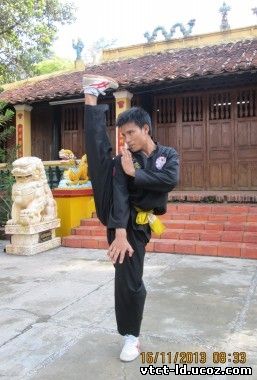11:24:58 The Distinctive Features Of Vietnamese Traditional Martial Arts |
* Grandmaster Truong Van Bao Vietnam Traditional Martial Arts Federation
Originally, Vietnamese traditional martial arts were used for battles. This type of martial arts makes use of empty-hand techniques and weapons for application in combat. Those who practice Vietnamese traditional martial arts will train the entire body as a natural weapon for striking, kicking, wrestling, grappling, etc. employing techniques that are executed by hands, feet, elbows, knees, shoulders, heads, hips and so on. Vietnamese traditional martial arts are complex and diverse. The basic principles of Vietnamese traditional martial arts are characterized by a very active approach that is clearly reflected in its spirit: Attacking for defense. A hand used for attack also serves to parry. A kick used for attack also serves to defend. Using soft to overcome hard. Using short to control long. Hands against hands. Hands against kicks. Kicks against hands. Kicks against kicks. Kicks against stances. Empty-hand techniques against weapons. Weapons against weapons. Morality The principle of Vietnamese Traditional Martial Arts is “morality first, techniques later”. Morality is taken to be important. Morality is the belief or recognition that certain behaviors are either “good” or “bad”. It is the determination of what should be done and what should not be done. Morals deal with behaviors as well as motives. Humanity and Martial Spirit Those who practice Vietnamese traditional martial arts do not strive to defeat others but to conquer themselves. The humanities are ways of thinking about what is human about our diverse histories, values, ideas, words and dreams. The humanities inspire us to ask who we are and what our lives should mean. Martial Spirit is very important for someone who wants to master martial arts. Martial Spirit is essential to understand and to acquire. The mind must be developed as well as the body. Philosophy Yin and Yang (two complimentary principles of Eastern philosophy). In Eastern philosophy, the concept of yin-yang, which is often called "yin and yang", is used to describe how seemingly opposite or contrary forces are interconnected and interdependent in the natural world; and, how they give rise to each other as they interrelate to one another. Five Basic Elements (Metal - Wood - Water - Fire - Earth; according to Eastern philosophy). There are Five Basic Elements in many philosophies and traditions around the world. This order of presentation is known as the "mutual generation" sequence. In the order of "mutual conquest" or "mutual overcoming" they are Metal, Wood, Water, Fire and Earth. Eight Trigrams (Heaven - Càn; Lake - Đoài; Fire - Ly; Thunder - Chấn; Wind - Tốn; Water - Khảm; Mountain - Cấn; Earth - Khôn). The Eight Symbols are eight trigrams used in Taoist cosmology to represent the fundamental principles of reality, seen as a range of eight interrelated concepts. In all cultures, symbols convey meaning. The eight trigrams are groups of symbols that hold deep meaning in Eastern philosophy. These eight symbols are representations of naturally occurring processes. They represent movement and change. Giáp Ngọ - 2014 T.V.B |
|
|
| Total comments: 0 | |
 Characteristics
Characteristics